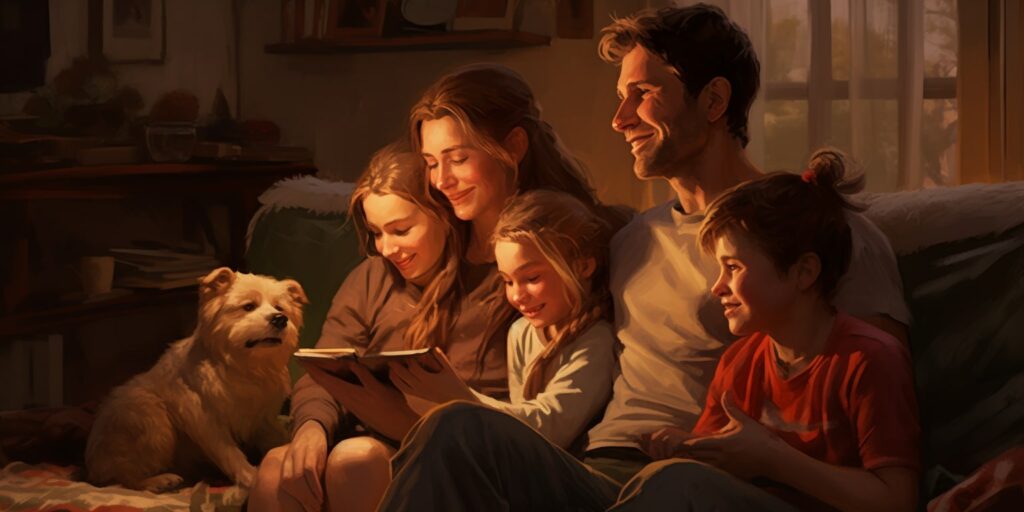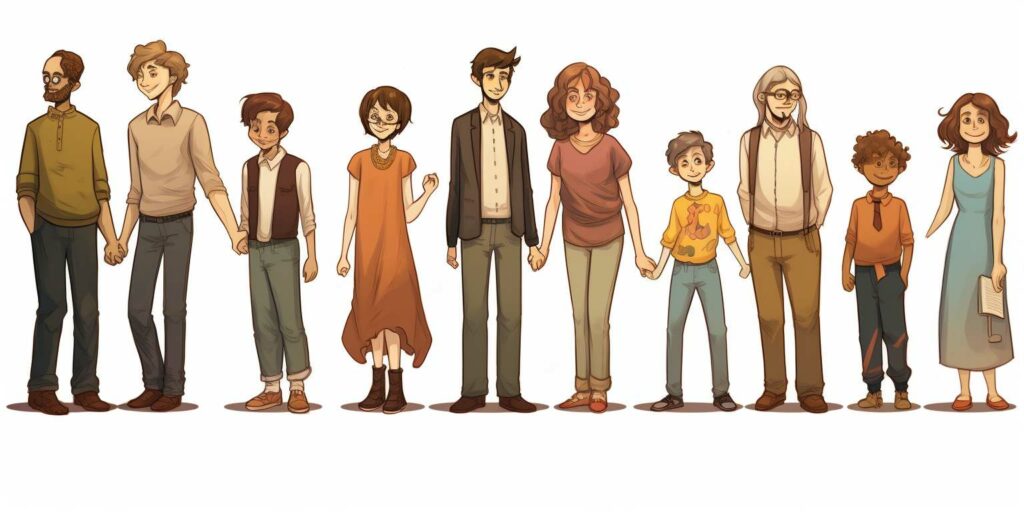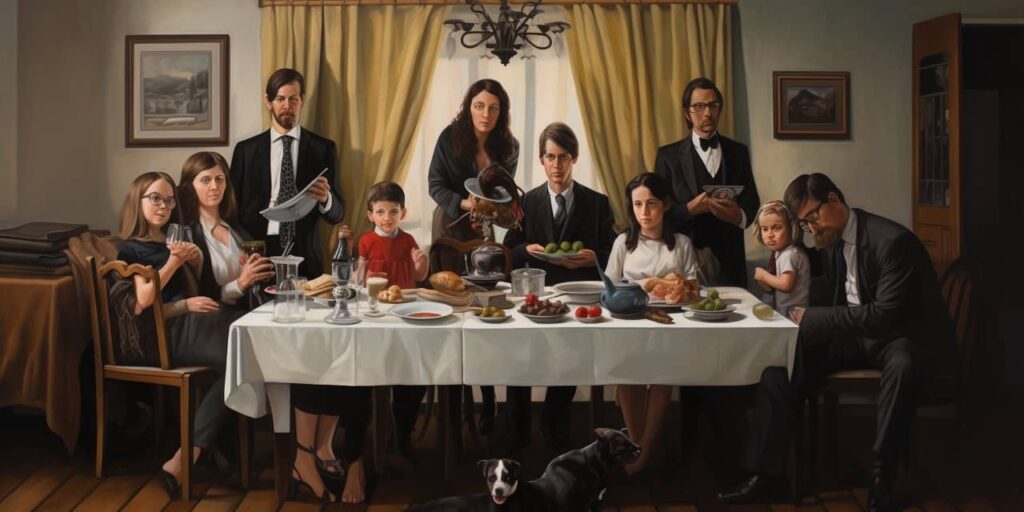When we think about families, it’s easy to default to the traditional idea: two parents and their biological children, living under one roof. But in reality, family structures are far more diverse and quite fascinating. Family types vary greatly from culture to culture, time period to time period, and even person to person.
I’ve spent a considerable amount of time studying this subject and I’ll tell you this – there isn’t just one type of family that fits all. From nuclear families to single parent households, extended families to childless couples, each has its unique dynamics and values worth exploring. In fact, understanding these different family types can enrich our perspective on societal norms.
In today’s world where change is the only constant, it’s important for us to broaden our concept of what constitutes a ‘family’. Whether you’re part of a blended family or an adoptive one; whether you live with your grandparents or have foster siblings – every familial setup has its own beauty and challenges. Let’s dive into these different types of families together so we can appreciate the diversity around us.
Understanding the Concept of Family
Diving right into the heart of our topic, I’d like to talk about what “family” really means. Now, it’s not just about sharing a last name or living under the same roof. The concept of family extends far beyond these traditional notions and encompasses a broad range of relationships and structures.
In today’s diverse society, we see a variety of family types that reflect our evolving culture. For instance, there are nuclear families, which consist of two parents and their kids. This is often what comes to mind when people say ‘family.’ But then we also have single-parent families where one parent shoulders all responsibilities due to varying circumstances – from divorce to death or even personal choice.
Let’s look at some numbers:
| Family Type | Percentage (%) |
|---|---|
| Nuclear Family | 46 |
| Single Parent Family | 26 |
*Source: US Census Bureau
Don’t forget blended families (or stepfamilies) as well! These families form when one or both partners bring children from previous relationships into a new union. And then there are extended families – grandparents, uncles, aunts; you name it – who play integral roles in many cultures around the world.
And guess what? We’ve still not covered all family types! There are childless families too – couples who opt not to have children for various reasons but provide each other with mutual support and companionship nonetheless.
The bottom line here is that no two families look exactly alike! It’s this diversity that adds richness to our social fabric and challenges us to be more inclusive in how we define ‘family.’ Our conversation doesn’t end here though… stay tuned as we delve deeper into each type in subsequent sections.
The Nuclear Family: Definition and Importance
Let’s dive right into the heart of the matter. A nuclear family, often called a traditional family, typically consists of two parents and their children living under one roof. It’s considered to be the smallest unit in society’s family structure.
Why is it so important? Well, this structure has long been perceived as vital for raising well-rounded kids. In fact, studies show that children growing up in nuclear families tend to fare better on several fronts. They’re reported to have higher academic achievement rates and exhibit better social development compared to those from non-nuclear families.
| Type of Family | Academic Achievement Rate |
|---|---|
| Nuclear | High |
| Non-nuclear | Low |
Now, let’s look at some real-life examples. Consider sitcoms like “The Simpsons” or “Family Guy.” These shows depict nuclear families, albeit with a comedic twist. Yet they illustrate how these units operate – navigating life’s ups and downs together.
However, it’d be wrong to say everything about nuclear families is rosy. Critics argue that this model can foster gender inequality since it often implies women should stay at home while men become breadwinners.
Here are some key points:
- Nuclear families consist of two parents and their children.
- Children from these households usually do well academically.
- Criticism includes potential reinforcement of gender roles.
Despite all debates around it, there’s no denying the impact that the nuclear family model has had on society over time. Its importance lies not just in its historical significance but also in its ongoing influence on contemporary societal norms.
Single Parent Families: Challenges and Strengths
I’ve often heard it said that being a parent is the hardest job in the world. Now, imagine doing that all on your own – welcome to the life of a single parent. It’s not an easy ride by any stretch, yet it comes with its unique strengths too.
Single parents face numerous challenges daily. They’re tasked with juggling work, children’s activities, household chores, and their personal needs single-handedly. Often times this leads to stress and burnout. The financial strain is another major hurdle for many single-parent families.
- According to U.S Census Bureau data from 2019:
Total Number Percent Single Mothers 15 million 81% Single Fathers 3.5 million 19%
This table shows us that majority of single parents are mothers which adds another layer of complexity due to wage gaps and social expectations.
However, it’s not all about adversity when we talk about single-parent families. There is a beautiful side too – resilience shines through these households like no other! These families may be small in number but they’re big on adaptability and problem-solving skills; traits children learn early on witnessing their solo parent tackle various hurdles.
Anecdotes abound where children from such families express immense pride in their hardworking parents who despite the odds have managed to provide them with a loving home environment.
Even though balancing everything can feel like tightrope walking at times for many single parents out there, they nonetheless manage to create healthy family environments fostering strong bonds between themselves and their kids.
So yes, while being a part of a single-parent family does come with its fair share of trials – it also brings forth some incredible strengths that deserve recognition as well!
Extended Family: A Pillar in Many Cultures
Digging into the concept of an extended family, it’s important to remember that this type of familial structure isn’t just a fad or trend. It’s deeply rooted in many cultures around the globe and has been for centuries.
In various cultures, the notion of an extended family includes not only parents and their children but also grandparents, aunts, uncles, cousins—basically anyone related by blood or marriage. For instance, in many Asian countries like India and China, it’s common for multiple generations to live under one roof. They share responsibilities such as child-rearing and household chores while providing emotional support to each other.
Let me pepper that fact with some numbers:
| Region | Percentage of Extended Families |
|---|---|
| Asia | 60% |
| Africa | 55% |
| Europe | 35% |
As you can see from the data above, these percentages are significantly high. This shows how deep-seated the value of extended families is in these regions.
Moving on, I’d like to share a heartwarming anecdote about my friend Maria who hails from Mexico—a culture where extended families are integral. Maria often shares stories about her large family gatherings every weekend at her grandmother’s house. She talks about the joyous chaos filled with laughter, shared meals and endless conversations that strengthen their bonds.
There are numerous advantages associated with living in an extended family setup:
- Sharing financial burdens
- Providing emotional support
- Instilling cultural values
However, it isn’t without its challenges such as privacy concerns and potential disagreements among members.
Peeling back the layers on ‘extended families’, we see they’re more than just larger versions of nuclear families—they’re complex social structures ingrained in our societies across continents. Whether it’s sharing laughs over dinner or helping each other through tough times—the essence lies in unity, love and respect.
Childless Families: An Increasing Trend
It’s no secret that societal norms are rapidly changing, and one trend that’s been on the rise is childless families. In recent years, more couples are choosing not to have children for a variety of reasons. Some simply enjoy the freedom and flexibility that comes with not having kids, while others may prioritize their careers or feel they can’t provide the emotional or financial support that raising a child requires.
According to data from the U.S Census Bureau:
| Year | Percentage of Childless Women Aged 15-44 |
|---|---|
| 1976 | 35% |
| 2006 | 45% |
| 2018 | 47.6% |
This increase isn’t just happening in America though; it’s a global trend. For instance, in Germany, almost a quarter of women born in the early ’60s remained childless – one of the highest rates in Europe.
While there’s certainly nothing wrong with choosing not to have children, it does create an interesting dynamic within society. Childless families often face judgment or criticism from those who hold traditional views about family structure. They’re sometimes seen as selfish or thought to be missing out on a key part of life.
However, these perceptions are slowly changing as our understanding of what constitutes a ‘family’ evolves. Today, many people believe that family isn’t necessarily defined by blood relations but by love and commitment instead.
So why this growing preference for childlessness? It seems multiple factors contribute:
- Economic pressures: The cost of raising children has skyrocketed over the years.
- Focus on personal growth/career: Many choose to invest time into self-improvement and professional advancement.
- Concerns about overpopulation/environment: Some opt not to bring another life into an already crowded world.
In conclusion (without using “in conclusion”), childless families are becoming more common in today’s society. It’s an evolving trend that reflects our changing attitudes towards family and parenthood. As we move forward, it’ll be interesting to see how this shift impacts social norms and policies around the globe.
Blended Families: The New Norm?
In recent years, I’ve noticed a significant shift in the traditional family structure. It’s not all about mom, dad, and 2.5 kids anymore. Blended families are steadily becoming more common.
Blended families come into existence when parents bring children from previous relationships together to form a new family unit. This type of family can include half-siblings, step-siblings, and both biological parents or one biological parent with a step-parent.
Here’s an interesting fact: According to the U.S Census Bureau, approximately 16% of children live in blended families. That’s quite a substantial number! Let me give you some perspective:
| Child Lives With | Percentage |
|---|---|
| Both Parents (biological) | 61% |
| Single Mother | 23% |
- Blended Family | 16% |
I’ve been pondering why this shift is happening? Could it be because divorce rates are high? Or maybe there’s less stigma attached to being part of a blended family these days? Well, it seems like it’s probably a combination of factors.
For instance:
- Divorce rates: Although they have decreased slightly over time, around 40%-50% of marriages in the US still end in divorce.
- Remarriage: Most people don’t stay single forever after divorce. In fact, according to Pew Research Center data, two-thirds of divorced people remarry.
- Changing societal norms: Society has become more accepting of different types of families – including those formed by remarriage or cohabitation.
This rise in blended families has its challenges though. There can be conflicts between step-siblings or difficulties adjusting for children who move between households if joint custody is involved. But let’s not lose sight that every type of family has its own unique set of challenges – so does traditional nuclear families!
Remember this, blended families can also be wonderful and fulfilling. They provide opportunities for relationships and bonds that might not have been possible otherwise. So, let’s move away from the idea of a “normal” family structure. Because, frankly, in today’s world there isn’t one. The norm is what works best for each individual family!
Adoptive Families: Love Beyond Blood Relations
I’m here today to delve into a unique type of family that holds a special place in society – the adoptive family. These families are bound not by blood relations, but by an unyielding bond of love and acceptance.
Adoptive families come in all shapes and sizes. There’s no one-size-fits-all model here. Some consist of parents who’ve chosen to expand their family through adoption after having biological children, while others might be made up entirely of adopted individuals. Then there are those where the grandparents or other relatives step in to adopt when the biological parents can’t provide adequate care.
In 2019, according to data from the U.S. Department of Health & Human Services, over 122,000 children were waiting for adoptive families*. This statistic alone highlights the significant role these families play in providing loving homes to those who need them most.
| Year | Children Awaiting Adoption |
|---|---|
| 2019 | Over 122,000 |
Yet it’s important to remember that every adoption journey is unique. Each comes with its own set of triumphs and challenges. For instance, some adoptive parents may face hurdles during the adoption process itself – which can be a complex legal procedure requiring patience and determination.
On top of this, once an adoption is finalized, there may be emotional hurdles as well; adjusting to new dynamics within the home environment takes time for both parent(s) and child(ren). But despite these potential obstacles, one thing remains constant; The deep love that forms between members of an adoptive family transcends traditional definitions and expectations about what ‘family’ should look like.
It’s worth noting that research has shown adopted children typically fare just as well emotionally and socially as their non-adopted peers**. This is testament not only to their resilience but also to the nurturing environments provided by adoptive families.
| Adopted Children | Emotional and Social Well-being |
|---|---|
| Typical | Comparable to non-adopted peers |
Adoptive families represent a love beyond blood relations. They’re proof that family isn’t just about genetics, it’s about commitment, understanding, and unequivocal love.
*U.S. Department of Health & Human Services, AFCARS Report No. 26
**Vandivere S., Malm K., Radel L., “Adoption USA: A Chartbook Based on the 2007 National Survey of Adoptive Parents”. U.S. Department of Health and Human Services (2009)
Conclusion: The Beauty of Diverse Family Types
Diversity in family types is truly a beauty to behold. It’s like a vibrant tapestry woven with threads of various colors and textures. Each type of family brings its own unique strengths and challenges, making our society more dynamic and interesting.
Let me emphasize that no one type of family is inherently superior or inferior to another. It’s the love, respect, and bonds within a family that matter most. Nuclear families, single-parent families, extended families – each has its own set of values and traditions that contribute to the rich cultural fabric of our world.
I’ve discovered through my research just how much these diverse types can learn from each other:
- Nuclear Families provide an intimate environment where children can flourish under the direct care of both parents.
- Single-Parent Families, on the other hand, exemplify strength in adversity as they tackle parenting roles alone.
- Extended Families teach us about community spirit as multiple generations live together sharing responsibilities.
These are just examples; there are many more types out there! They all show us different ways to navigate life’s ups and downs while fostering strong familial connections.
Remember this: what makes a family isn’t solely defined by blood ties or legal bonds but also by shared experiences, mutual support, enduring commitment, and unconditional love. Every kind strengthens our societal structure in its own unique way.
So let’s embrace the diversity among families – it enriches us all by providing varying perspectives on life’s journey. We should celebrate every type for contributing valuable lessons about resilience, unity, adaptability, patience; attributes we all need in abundance!
In wrapping up this article on diverse family types, I hope you’ve gained new insights into their inherent beauty. Let’s continue learning from each other because after all – it takes a village to raise a child!



